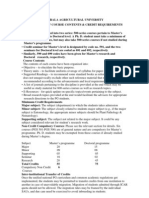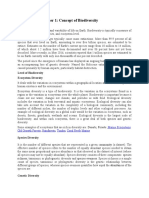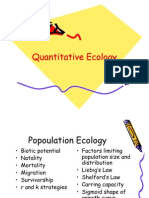Forest Management
Forest Management
Uploaded by
sandeep0109Copyright:
Available Formats
Forest Management
Forest Management
Uploaded by
sandeep0109Original Description:
Copyright
Available Formats
Share this document
Did you find this document useful?
Is this content inappropriate?
Copyright:
Available Formats
Forest Management
Forest Management
Uploaded by
sandeep0109Copyright:
Available Formats
Forest Management
Forest Management is the branch of forestry concerned with the overall administrative, economic, legal, and social aspects and with the essentially scientific and technical aspects, especially silviculture, protection, and forest regulation. This includes management for aesthetics, fish, recreation, urban values, water, wilderness, wildlife, wood products, and other forest resource values. Management can be based on conservation, economics, or a mixture of the two. Techniques include the extraction timber, planting and replanting of various species, cutting roads and pathways through forests, and preventing of fire. In developed countries, the environment has increased public awareness of natural resource policy, including forest management. As a direct result, primary concerns regarding forest management have shifted from the extraction of timber to other forest resources including wildlife, watershed management, and recreation. This shift in public values has also caused many in the public to mistrust resource management professionals. Community Forestry Community Forestry has been considered one of the most promising options of combining forest conservation with rural development and poverty reduction objectives. Community Forestry is implemented firstly through the establishment of a legal and institutional framework including the revision of legal norms and regulations for forest management, the development of National Forest Plans and the strengthening of decentralization processes to sub-national levels of government. The second principle line of action is the implementation of pilot projects to demonstrate the feasibility of the Community Forestry Framework. However, a study by the Overseas Development Institute shows that the technical, managerial and financial requirements stipulated by the framework are often incompatible with local realities and interests. A successful legal and institutional framework will incorporate the strengthening of existing institutions and enable the dissemination of locally appropriate practices as well as the local capacity for regulation and control Forest farming is an agroforestry practice characterized by the four "I's"- Intentional, Integrated, Intensive and Interactive management of an existing forested ecosystem wherein forest health is of paramount concern. It is neither forestry nor farming in the traditional sense.
Forest farm management principles constitute an ecological approach to forest management through efforts to find a balance between conservation of native biodiversity and wildlife habitat within the forest and limited, judicious utilization of the forest's varied resources. It attempts to bring secondary growth forests that have been overused and whose ecosystems have become so fragmented that their natural processes are out of equilibrium, back into ecological balance through careful, intentional manipulation over time, emulating natural processes to restore original, natural diversity of species and ecosystem stability. In some instances, the intentional introduction of native or native-related species for use as botanicals, medicinals or food products is accomplished, utilizing the existing forest ecosystem to aid in support of their growth. The tree cover, soil type, water supply, landform and other site characteristics determine what species will thrive, as opposed to field-grown crop plantings. Developing an understanding of species/site relationships as well as understanding the site limitations is necessary in order to utilize these resources for current needs, while conserving adequate resources for the health of the forest today and for the future. Forest farm management methods may include: Intensive, yet cautious thinning of overstocked, suppressed tree stands such that no individual species is decimated and such that the crown cover is never depleted leaving the forest floor exposed to excessive sun, rain and erosion ; multiple Integrated entries to accomplish thinnings so that the systemic shock is not so great; and Interactive management to maintain a cross-section of healthy trees and shrubs of all ages and species, rather than a monoculture of timber species. Caution is used to ensure that physical disturbance to the surrounding area is minimized in order for the forest ecosystem to recover more quickly. Forest farm management is a type of forest stewardship ethic whose philosophy is that the term "sustainable" means what is sustainable for the earth, not what is sustainable for man's demand, and its objective is to restore and maintain the health of the forest land's many and varied ecosystems. In recent years, the concept of ecosystem serviceshas been developed to satisfy the human demand for a means of participating actively in support of ecosystem health and appreciation of the earth's natural assets. This movement is taking many physical formsthe planting of trees; the leaving of timber to grow older; the protection of forest habitat for
animal species; creek riparian enhancement. Forest health is already a priority and is currently undertaken on forest farms as part of the management program. This positions them well to respond to this societal need, of conservation-minded individuals who are willing to provide monetary support for the program.
You might also like
- Computer Repair Business PlanDocument31 pagesComputer Repair Business PlanAnselm66% (38)
- Clark SM 520r Service ManualDocument20 pagesClark SM 520r Service Manualbelinda100% (63)
- Behavioral Ecology QuestionsDocument1 pageBehavioral Ecology Questionszylin555No ratings yet
- Biological Basis of Wildlife ManagementDocument20 pagesBiological Basis of Wildlife ManagementSachin ShrivastavNo ratings yet
- Wildlife Managment and Conservation Lect 1Document10 pagesWildlife Managment and Conservation Lect 1Rukhsana HabibNo ratings yet
- Alemayehu Lemessa - ThesisDocument81 pagesAlemayehu Lemessa - ThesisgezahegnNo ratings yet
- Biotechnology: HistoryDocument3 pagesBiotechnology: HistorySheena Mari Uy ElleveraNo ratings yet
- Natural Resources: Panipat Institute of Engineering and TechnologyDocument51 pagesNatural Resources: Panipat Institute of Engineering and TechnologysumankhuranaNo ratings yet
- Chapter 1 - Introduction To EcologyDocument19 pagesChapter 1 - Introduction To EcologyHaziq Iskandar ShamsulNo ratings yet
- Biodivesity PPT For Environment ScienceDocument19 pagesBiodivesity PPT For Environment ScienceMohammadFaisalQureshiNo ratings yet
- Biodiversity and Its ConservationDocument48 pagesBiodiversity and Its Conservationvhon bryan buhat silvanoNo ratings yet
- Lecture 6 Community-Based Natural Resources ManagementDocument10 pagesLecture 6 Community-Based Natural Resources ManagementArlene Mae CaylanNo ratings yet
- THE Biosphere and Its Natural ResourcesDocument28 pagesTHE Biosphere and Its Natural ResourcesDoods GaldoNo ratings yet
- Forms of Agroforestry SystemDocument16 pagesForms of Agroforestry Systemj.cortez.525157No ratings yet
- PG Syllabus AgriDocument432 pagesPG Syllabus AgriJinu Madhavan100% (1)
- Ecosystem Restoration: Made By-Anshika KushwahaDocument10 pagesEcosystem Restoration: Made By-Anshika KushwahaShubhamNo ratings yet
- 3.0 The Ecosystems: Science, Environment and SocietyDocument39 pages3.0 The Ecosystems: Science, Environment and SocietyKookie BTS100% (1)
- Social Issues and The EnvironmentDocument17 pagesSocial Issues and The Environmentbhavi kocharNo ratings yet
- ENV 107 Nutrient-Biogeochemical Cycle 7-8Document67 pagesENV 107 Nutrient-Biogeochemical Cycle 7-8Orvin Johannes100% (1)
- Ecosystem & Diversity PDFDocument23 pagesEcosystem & Diversity PDFSSr ReddyNo ratings yet
- Natural ResourcesDocument13 pagesNatural ResourcesAjaya Kumar MohapatraNo ratings yet
- Solid Waste Management New PDFDocument3 pagesSolid Waste Management New PDFraja velNo ratings yet
- Causes of Land Degradation of Urban AreasDocument4 pagesCauses of Land Degradation of Urban AreasSanjit TambeNo ratings yet
- Biodiversity and ConservationDocument21 pagesBiodiversity and ConservationErvin VasaylajeNo ratings yet
- Behavioral: Photo From Wikimedia CommonsDocument27 pagesBehavioral: Photo From Wikimedia CommonsLance CarandangNo ratings yet
- Forest BiometryDocument13 pagesForest BiometrySlowSolid NotLiquidNo ratings yet
- Lec 4 AgrometeorologyDocument9 pagesLec 4 AgrometeorologyabNo ratings yet
- Forest ConservationDocument33 pagesForest ConservationJay GrijaldoNo ratings yet
- Succession: (Climax Community)Document38 pagesSuccession: (Climax Community)KanchanNo ratings yet
- Ecological SuccessionDocument14 pagesEcological Successionanjuanjutti03No ratings yet
- Boundaries of EcosystemDocument7 pagesBoundaries of EcosystemUj UmarNo ratings yet
- Autecology and SynecologyDocument2 pagesAutecology and SynecologyakintobitoluwanimiNo ratings yet
- Application of GIS in Environmental ManagementDocument4 pagesApplication of GIS in Environmental ManagementAnuradha JayaramanNo ratings yet
- Measuring Biodiversity: See The Associated Lesson Plan atDocument17 pagesMeasuring Biodiversity: See The Associated Lesson Plan atapi-243961057No ratings yet
- Ecosystem ProductivityDocument2 pagesEcosystem ProductivityvijendNo ratings yet
- Energy and Nutrient Relations 2023Document36 pagesEnergy and Nutrient Relations 2023Dez Tubod100% (1)
- Community Ecology PowerpointDocument31 pagesCommunity Ecology PowerpointNGNo ratings yet
- Fundamentals of Soil Science: NRMH 1.1 (2 + 1) First Semester B.Sc. (Hons.) HorticultureDocument38 pagesFundamentals of Soil Science: NRMH 1.1 (2 + 1) First Semester B.Sc. (Hons.) HorticultureMakarim Khusnul100% (1)
- Unit-1 Environment & Natural Resources.Document94 pagesUnit-1 Environment & Natural Resources.Manav JainNo ratings yet
- Ecological PyramidsDocument19 pagesEcological Pyramidsnandhinidish100% (1)
- Restoration of The Ecological Process in Alexandria EgyptDocument31 pagesRestoration of The Ecological Process in Alexandria EgyptTmt TarekNo ratings yet
- 02-EnVI SCI - Ecological Principles and ConceptsDocument26 pages02-EnVI SCI - Ecological Principles and ConceptsJochebed ReyesNo ratings yet
- Biodiversity Conservation and Management For BSC Botany StudentsDocument41 pagesBiodiversity Conservation and Management For BSC Botany StudentsMadan ThapaNo ratings yet
- Module 4 Natural ResourcesDocument7 pagesModule 4 Natural ResourcesKarl angelo LorzanoNo ratings yet
- Environmental ScienceDocument5 pagesEnvironmental Sciencearijit_ghosh_18No ratings yet
- Biodiversity HotspotsDocument23 pagesBiodiversity HotspotsJithNo ratings yet
- Environ (1) - StudiesDocument121 pagesEnviron (1) - StudiesYash Verma86% (7)
- Unit - III Natural ResourcesDocument64 pagesUnit - III Natural ResourcesSATHYABAMA MADHANKUMARNo ratings yet
- Midterm Exam General Ecology Ws 2013-14-13900557Document2 pagesMidterm Exam General Ecology Ws 2013-14-13900557premoh0% (1)
- BiodiversityDocument75 pagesBiodiversityJohn DoeNo ratings yet
- Ecology Restoration - Lass NotesDocument46 pagesEcology Restoration - Lass NotesEr Manak Chand Saini100% (1)
- 03 BiosphereDocument37 pages03 BiosphereRonel A GaviolaNo ratings yet
- Chapter 4-BiodiversityDocument71 pagesChapter 4-BiodiversityRintu Raj PandeyNo ratings yet
- BiodiversityDocument66 pagesBiodiversityRahul ChaudharyNo ratings yet
- Quantitative EcologyDocument123 pagesQuantitative EcologyKrishnan JeevanNo ratings yet
- Cell Biology Handout - 1Document62 pagesCell Biology Handout - 1Dewi Lasimpara100% (1)
- For 111 Study MaterialDocument108 pagesFor 111 Study MaterialMothika SNo ratings yet
- SBT B309 - Advanced Plant Ecology - 2020Document39 pagesSBT B309 - Advanced Plant Ecology - 2020Stellamaris MutukuNo ratings yet
- Forestry Forest ManagementDocument2 pagesForestry Forest ManagementbharanikantNo ratings yet
- 1-10Document11 pages1-10Yaroslav KutsNo ratings yet
- Digital Art 290 FlashcardsDocument4 pagesDigital Art 290 FlashcardsDinas KesehatanNo ratings yet
- SFM For ExitDocument45 pagesSFM For ExittengertdereNo ratings yet
- Advanced Instrumental Methods For Identification of Components in FoodDocument15 pagesAdvanced Instrumental Methods For Identification of Components in FoodAnna TongcoNo ratings yet
- LIT 1 - BIBLE STORIES - Escobar, Kaye M.Document11 pagesLIT 1 - BIBLE STORIES - Escobar, Kaye M.KAYE ESCOBARNo ratings yet
- Testing Your Bow GripDocument2 pagesTesting Your Bow GripfalsechernNo ratings yet
- The Forgotten PathDocument2 pagesThe Forgotten PathDamith AbeysekeraNo ratings yet
- Haney v. Scientology: Amicus by NCOSEDocument14 pagesHaney v. Scientology: Amicus by NCOSETony OrtegaNo ratings yet
- Igo Hatsuyōron 120 - An Elephant in SlicesDocument106 pagesIgo Hatsuyōron 120 - An Elephant in SlicesАндрей ИвановNo ratings yet
- Thermodynamics Worked ExamplesDocument13 pagesThermodynamics Worked ExamplesSalah Salman100% (1)
- ETH111A Assignment - Krishna AgrawalDocument2 pagesETH111A Assignment - Krishna Agrawalkrishna50bloggingNo ratings yet
- Page 207Document1 pagePage 207Nicole Anne BorromeoNo ratings yet
- Maharashtra Board HSC Mathematics Question Paper 2016Document3 pagesMaharashtra Board HSC Mathematics Question Paper 2016Sneha GadgilNo ratings yet
- Mission 3-DatingDocument4 pagesMission 3-Datingapi-254971555No ratings yet
- Role of A Pharmacist in Health Care SystemDocument7 pagesRole of A Pharmacist in Health Care SystemAnna KhalidNo ratings yet
- Harrison Chapter5Document7 pagesHarrison Chapter5Zahirul Haq100% (1)
- RXM-M2V1B Databook EEDEN16Document35 pagesRXM-M2V1B Databook EEDEN16martijn.poolNo ratings yet
- Calculation & Discussion PFR CHE506Document9 pagesCalculation & Discussion PFR CHE506Wahyuningsih YuniNo ratings yet
- Installation and Owner's Manual: Console RecessedDocument55 pagesInstallation and Owner's Manual: Console Recessedkrutika sarinNo ratings yet
- Assessment of Water Fowl Diversity of River Chenab, PakistanDocument7 pagesAssessment of Water Fowl Diversity of River Chenab, PakistanAdnan AhmedNo ratings yet
- Falin-Math of Finance and Investment 3 PDFDocument97 pagesFalin-Math of Finance and Investment 3 PDFAlfred alegadoNo ratings yet
- Type 1259 Process Pressure Gauge: FeaturesDocument2 pagesType 1259 Process Pressure Gauge: FeaturesWilson Alberto Poveda OsorioNo ratings yet
- Raisoni Music Website SKDocument39 pagesRaisoni Music Website SKdgNo ratings yet
- Three Elements of ExerciseDocument1 pageThree Elements of ExerciseDisha TNo ratings yet
- Ulangan Harian 1. Bhs. InggrisDocument4 pagesUlangan Harian 1. Bhs. InggrisMuhammad Farhan FatahillahNo ratings yet
- Best UniversitiesDocument24 pagesBest Universitiesprateek gargNo ratings yet
- Department of Education: Classroom Readiness ChecklistDocument2 pagesDepartment of Education: Classroom Readiness ChecklistJEFFREY LOIS MAESTRADONo ratings yet
- L-s1 Specification For Low Voltage Internal Electrical InstallationDocument154 pagesL-s1 Specification For Low Voltage Internal Electrical InstallationKNS CSBNo ratings yet
- PRINCIPLE of ARTS Visual Arts Categories of ArtDocument4 pagesPRINCIPLE of ARTS Visual Arts Categories of ArtCarlo PadilloNo ratings yet
- New w7 Cholesterol, Triglyceride Determination, HDL CholesterolDocument118 pagesNew w7 Cholesterol, Triglyceride Determination, HDL Cholesterollily beautyNo ratings yet
- Service Encounter: by Dr. Nripendra Singh Jaypee Business School, Noida AgendaDocument22 pagesService Encounter: by Dr. Nripendra Singh Jaypee Business School, Noida AgendaMukul MudgalNo ratings yet

























































































